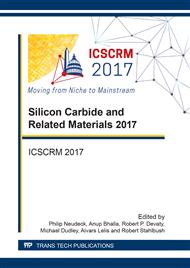p.353
p.357
p.361
p.365
p.369
p.373
p.377
p.381
p.385
4H-Silicon Carbide Wafer Surface after Chlorine Trifluoride Gas Etching
Abstract:
In order to develop the high etching rate reactor for silicon carbide, the 50-mm-diameter C-face 4H-silicon carbide wafer was etched using the chlorine trifluoride gas at 500 °C. By the deep etching, the concentric-circle-shaped valleys were formed at the positions corresponding to the radii of the pin-hole arrays of the gas distributor, as predicted by the calculation. The etching rate profile of 4H-silicon carbide was concluded to have a relationship with the local chlorine trifluoride gas supply . The wafer bow was small, even the wafer was very thin, about 160 μm thick.
Info:
Periodical:
Pages:
369-372
Citation:
Online since:
June 2018
Permissions:
Share:
Citation:


